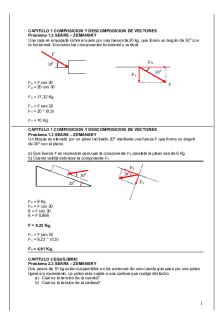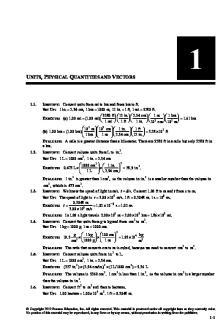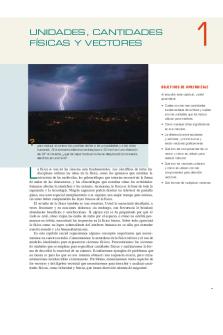Física Universitaria. Solucionario. Vol I & II. Sears & Zemansky. 13ra edición (University Physics. Solutions manual. 13th edition) PDF

| Title | Física Universitaria. Solucionario. Vol I & II. Sears & Zemansky. 13ra edición (University Physics. Solutions manual. 13th edition) |
|---|---|
| Author | Soph Prz |
| Pages | 1,400 |
| File Size | 24.5 MB |
| File Type | |
| Total Downloads | 351 |
| Total Views | 812 |
Summary
UNITS, PHYSICAL QUANTITIES AND VECTORS 1 1.1. IDENTIFY: Convert units from mi to km and from km to ft. SET UP: 1 in. = 2.54 cm, 1 km = 1000 m, 12 in. = 1 ft, 1 mi = 5280 ft. ⎛ 5280 ft ⎞ ⎛ 12 in. ⎞ ⎛ 2.54 cm ⎞ ⎛ 1 m ⎞ ⎛ 1 km ⎞ EXECUTE: (a) 1.00 mi = (1.00 mi) ⎜ = 1.61 km ⎝ 1 mi ⎟⎠ ⎜⎝ 1 ft ⎟⎠ ⎜⎝ 1 in....
Description
UNITS, PHYSICAL QUANTITIES AND VECTORS
1.1.
1
IDENTIFY: Convert units from mi to km and from km to ft. SET UP: 1 in. = 2.54 cm, 1 km = 1000 m, 12 in. = 1 ft, 1 mi = 5280 ft.
⎛ 5280 ft ⎞ ⎛ 12 in. ⎞ ⎛ 2.54 cm ⎞ ⎛ 1 m ⎞ ⎛ 1 km ⎞ = 1.61 km EXECUTE: (a) 1.00 mi = (1.00 mi) ⎜ ⎝ 1 mi ⎟⎠ ⎜⎝ 1 ft ⎟⎠ ⎜⎝ 1 in. ⎟⎠ ⎜⎝ 102 cm ⎟⎠ ⎜⎝ 103 m ⎟⎠
1.2.
⎛ 103 m ⎞⎛ 102 cm ⎞ ⎛ 1 in. ⎞⎛ 1 ft ⎞ 3 (b) 1.00 km = (1.00 km) ⎜ ⎟⎜ ⎟ = 3.28 × 10 ft ⎜ 1 km ⎟⎜ ⎟⎜ 1 m ⎟⎟ ⎝⎜ 2.54 cm ⎠⎝ 12 in . ⎠ ⎝ ⎠⎝ ⎠ EVALUATE: A mile is a greater distance than a kilometer. There are 5280 ft in a mile but only 3280 ft in a km. IDENTIFY: Convert volume units from L to in.3. SET UP: 1 L = 1000 cm3. 1 in. = 2.54 cm
⎛ 1000 cm3 ⎞ ⎛ 1 in. ⎞3 3 EXECUTE: 0.473 L × ⎜ ⎟⎟ × ⎜ ⎟ = 28.9 in. . ⎜ 1L 2 54 cm . ⎠ ⎝ ⎠ ⎝ EVALUATE: 1 in.3 is greater than 1 cm3 , so the volume in in.3 is a smaller number than the volume in 1.3.
cm3 , which is 473 cm3. IDENTIFY: We know the speed of light in m/s. t = d/v. Convert 1.00 ft to m and t from s to ns. SET UP: The speed of light is v = 3.00 × 108 m/s. 1 ft = 0.3048 m. 1 s = 109 ns. 0.3048 m EXECUTE: t = = 1.02 × 1029 s = 1.02 ns 3.00 × 108 m/s EVALUATE: In 1.00 s light travels 3.00 × 108 m = 3.00 × 105 km = 1.86 × 105 mi.
1.4.
IDENTIFY: Convert the units from g to kg and from cm3 to m3. SET UP: 1 kg = 1000 g. 1 m = 1000 cm. EXECUTE: 19.3
3
⎛ 1 kg ⎞ ⎛ 100 cm ⎞ kg × × = 1.93 × 104 3 3 ⎜ 1000 g ⎟ ⎜ 1 m ⎟ cm ⎝ m ⎠ ⎝ ⎠ g
EVALUATE: The ratio that converts cm to m is cubed, because we need to convert cm3 to m3. 1.5.
IDENTIFY: Convert volume units from in.3 to L. SET UP: 1 L = 1000 cm3. 1 in. = 2.54 cm. EXECUTE: (327 in.3 ) × (2.54 cm/in.)3 × (1 L/1000 cm3 ) = 5.36 L EVALUATE: The volume is 5360 cm3. 1 cm3 is less than 1 in.3 , so the volume in cm3 is a larger number
than the volume in in.3. 1.6.
IDENTIFY: Convert ft 2 to m 2 and then to hectares. SET UP: 1.00 hectare = 1.00 × 104 m 2 . 1 ft = 0.3048 m.
© Copyright 2012 Pearson Education, Inc. All rights reserved. This material is protected under all copyright laws as they currently exist. No portion of this material may be reproduced, in any form or by any means, without permission in writing from the publisher.
1-1
1-2
Chapter 1
⎛ 43,600 ft 2 ⎞ ⎛ 0.3048 m ⎞2 ⎛ 1.00 hectare ⎞ EXECUTE: The area is (12.0 acres) ⎜ = 4.86 hectares. ⎟⎟ ⎜ ⎟ ⎜ 4 2⎟ ⎜ ⎝ 1 acre ⎠ ⎝ 1.00 ft ⎠ ⎝ 1.00 × 10 m ⎠ EVALUATE: Since 1 ft = 0.3048 m, 1 ft 2 = (0.3048) 2 m 2 . 1.7.
IDENTIFY: Convert seconds to years. SET UP: 1 billion seconds = 1 × 109 s. 1 day = 24 h. 1 h = 3600 s.
⎛ 1 h ⎞ ⎛ 1 day ⎞ ⎛ 1 y ⎞ = 31.7 y. EXECUTE: 1.00 billion seconds = (1.00 × 109 s) ⎜ ⎝ 3600 s ⎟⎠ ⎜⎝ 24 h ⎟⎠ ⎜⎝ 365 days ⎟⎠ EVALUATE: The conversion 1 y = 3.156 × 107 s assumes 1 y = 365.24 d, which is the average for one 1.8.
1.9.
extra day every four years, in leap years. The problem says instead to assume a 365-day year. IDENTIFY: Apply the given conversion factors. SET UP: 1 furlong = 0.1250 mi and 1 fortnight = 14 days. 1 day = 24 h.
⎛ 0.125 mi ⎞⎛ 1 fortnight ⎞ ⎛ 1 day ⎞ EXECUTE: (180,000 furlongs/fortnight) ⎜ ⎟⎜ ⎟⎜ ⎟ = 67 mi/h ⎝ 1 furlong ⎠⎝ 14 days ⎠ ⎝ 24 h ⎠ EVALUATE: A furlong is less than a mile and a fortnight is many hours, so the speed limit in mph is a much smaller number. IDENTIFY: Convert miles/gallon to km/L. SET UP: 1 mi = 1.609 km. 1 gallon = 3.788 L. ⎛ 1.609 km ⎞⎛ 1 gallon ⎞ EXECUTE: (a) 55.0 miles/gallon = (55.0 miles/gallon) ⎜ ⎟⎜ ⎟ = 23.4 km/L. ⎝ 1 mi ⎠⎝ 3.788 L ⎠ 1500 km 64.1 L = 64.1 L. = 1.4 tanks. 23.4 km/L 45 L/tank EVALUATE: 1 mi/gal = 0.425 km/L. A km is very roughly half a mile and there are roughly 4 liters in a
(b) The volume of gas required is
gallon, so 1 mi/gal ∼ 24 km/L, which is roughly our result. 1.10.
IDENTIFY: Convert units. SET UP: Use the unit conversions given in the problem. Also, 100 cm = 1 m and 1000 g = 1 kg.
ft ⎛ mi ⎞ ⎛ 1 h ⎞⎛ 5280 ft ⎞ EXECUTE: (a) ⎜ 60 ⎟ ⎜ ⎟⎜ ⎟ = 88 h 3600 s 1 mi s ⎝ ⎠⎝ ⎠⎝ ⎠ m ⎛ ft ⎞ ⎛ 30.48 cm ⎞ ⎛ 1 m ⎞ (b) ⎜ 32 2 ⎟ ⎜ ⎟⎜ ⎟ = 9.8 2 1 ft 100 cm s ⎝ s ⎠⎝ ⎠ ⎠⎝ 3
g ⎞⎛ 100 cm ⎞ ⎛ 1 kg ⎞ ⎛ 3 kg (c) ⎜1.0 3 ⎟⎜ ⎟ = 10 3 ⎟ ⎜ m ⎝ cm ⎠⎝ 1 m ⎠ ⎝ 1000 g ⎠
EVALUATE: The relations 60 mi/h = 88 ft/s and 1 g/cm3 = 103 kg/m3 are exact. The relation 1.11.
32 ft/s 2 = 9.8 m/s 2 is accurate to only two significant figures. IDENTIFY: We know the density and mass; thus we can find the volume using the relation density = mass/volume = m/V . The radius is then found from the volume equation for a sphere and the result for the volume. SET UP: Density = 19.5 g/cm3 and mcritical = 60.0 kg. For a sphere V = 43 π r 3.
⎛ 60.0 kg ⎞ ⎛ 1000 g ⎞ 3 EXECUTE: V = mcritical /density = ⎜⎜ 3⎟ ⎟ ⎜ 1.0 kg ⎟ = 3080 cm . 19 . 5 g/cm ⎝ ⎠ ⎝ ⎠ 3V 3 3 = (3080 cm3 ) = 9.0 cm. 4π 4π EVALUATE: The density is very large, so the 130-pound sphere is small in size. r=3
© Copyright 2012 Pearson Education, Inc. All rights reserved. This material is protected under all copyright laws as they currently exist. No portion of this material may be reproduced, in any form or by any means, without permission in writing from the publisher.
Units, Physical Quantities and Vectors 1.12.
1-3
IDENTIFY: Convert units. SET UP: We know the equalities 1 mg = 10−3 g, 1 µg 10−6 g, and 1 kg = 103 g.
⎛ 10−3 g ⎞⎛ 1 μ g ⎞ 5 EXECUTE: (a) (410 mg/day) ⎜ ⎟⎜ −6 ⎟ = 4.10 × 10 μ g/day. ⎝ 1 mg ⎠ ⎝ 10 g ⎠ ⎛ 10−3 g ⎞ = 0.900 g. (b) (12 mg/kg)(75 kg) = (900 mg) ⎜ ⎜ 1 mg ⎟⎟ ⎝ ⎠ ⎛ 10−3 g ⎞ −3 (c) The mass of each tablet is (2.0 mg) ⎜ ⎟ = 2.0 × 10 g/day. The number of tablets required each ⎝ 1 mg ⎠ day is the number of grams recommended per day divided by the number of grams per tablet: 0.0030 g/day = 1.5 tablet/day. Take 2 tablets each day. 2.0 × 10−3 g/tablet
1.13.
1.14.
⎛ 1 mg ⎞ (d) (0.000070 g/day) ⎜⎜ −3 ⎟⎟ = 0.070 mg/day. ⎝ 10 g ⎠ EVALUATE: Quantities in medicine and nutrition are frequently expressed in a wide variety of units. IDENTIFY: The percent error is the error divided by the quantity. SET UP: The distance from Berlin to Paris is given to the nearest 10 km. 10 m EXECUTE: (a) = 1.1 × 10−3,. 890 × 103 m (b) Since the distance was given as 890 km, the total distance should be 890,000 meters. We know the total distance to only three significant figures. EVALUATE: In this case a very small percentage error has disastrous consequences. IDENTIFY: When numbers are multiplied or divided, the number of significant figures in the result can be no greater than in the factor with the fewest significant figures. When we add or subtract numbers it is the location of the decimal that matters. SET UP: 12 mm has two significant figures and 5.98 mm has three significant figures. EXECUTE: (a) (12 mm) × (5.98 mm) = 72 mm 2 (two significant figures)
5.98 mm = 0.50 (also two significant figures) 12 mm (c) 36 mm (to the nearest millimeter) (d) 6 mm (e) 2.0 (two significant figures) EVALUATE: The length of the rectangle is known only to the nearest mm, so the answers in parts (c) and (d) are known only to the nearest mm. IDENTIFY: Use your calculator to display π × 107. Compare that number to the number of seconds in a year. SET UP: 1 yr = 365.24 days, 1 day = 24 h, and 1 h = 3600 s. (b)
1.15.
1.16.
⎛ 24 h ⎞ ⎛ 3600 s ⎞ 7 7 7 EXECUTE: (365.24 days/1 yr) ⎜ ⎟⎜ ⎟ = 3.15567…× 10 s; π × 10 s = 3.14159…× 10 s 1 day 1 h ⎠ ⎝ ⎠⎝ The approximate expression is accurate to two significant figures. The percent error is 0.45%. EVALUATE: The close agreement is a numerical accident. IDENTIFY: Estimate the number of people and then use the estimates given in the problem to calculate the number of gallons. SET UP: Estimate 3 × 108 people, so 2 × 108 cars. EXECUTE: (Number of cars × miles/car day)/(mi/gal) = gallons/day (2 × 108 cars × 10000 mi/yr/car × 1 yr/365 days)/(20 mi/gal) = 3 × 108 gal/day
1.17.
EVALUATE: The number of gallons of gas used each day approximately equals the population of the U.S. IDENTIFY: Express 200 kg in pounds. Express each of 200 m, 200 cm and 200 mm in inches. Express 200 months in years.
© Copyright 2012 Pearson Education, Inc. All rights reserved. This material is protected under all copyright laws as they currently exist. No portion of this material may be reproduced, in any form or by any means, without permission in writing from the publisher.
1-4
Chapter 1 SET UP: A mass of 1 kg is equivalent to a weight of about 2.2 lbs.1 in. = 2.54 cm. 1 y = 12 months.
1.18.
EXECUTE: (a) 200 kg is a weight of 440 lb. This is much larger than the typical weight of a man. ⎛ 1 in. ⎞ 3 (b) 200 m = (2.00 × 104 cm) ⎜ ⎟ = 7.9 × 10 inches. This is much greater than the height of a ⎝ 2.54 cm ⎠ person. (c) 200 cm = 2.00 m = 79 inches = 6.6 ft. Some people are this tall, but not an ordinary man. (d) 200 mm = 0.200 m = 7.9 inches. This is much too short. ⎛ 1y ⎞ (e) 200 months = (200 mon) ⎜ ⎟ = 17 y. This is the age of a teenager; a middle-aged man is much ⎝ 12 mon ⎠ older than this. EVALUATE: None are plausible. When specifying the value of a measured quantity it is essential to give the units in which it is being expressed. IDENTIFY: The number of kernels can be calculated as N = Vbottle /Vkernel . SET UP: Based on an Internet search, Iowa corn farmers use a sieve having a hole size of 0.3125 in. ≅ 8 mm to remove kernel fragments. Therefore estimate the average kernel length as 10 mm, the width as 6 mm and the depth as 3 mm. We must also apply the conversion factors 1 L = 1000 cm3 and 1 cm = 10 mm. EXECUTE: The volume of the kernel is: Vkernel = (10 mm)(6 mm)(3 mm) = 180 mm3. The bottle’s volume
is: Vbottle = (2.0 L)[(1000 cm3 )/(1.0 L)][(10 mm)3 /(1.0 cm)3 ] = 2.0 × 106 mm3. The number of kernels is then N kernels = Vbottle /Vkernels ≈ (2.0 × 106 mm3 )/(180 mm3 ) = 11,000 kernels.
1.19.
1.20.
EVALUATE: This estimate is highly dependent upon your estimate of the kernel dimensions. And since these dimensions vary amongst the different available types of corn, acceptable answers could range from 6,500 to 20,000. IDENTIFY: Estimate the number of pages and the number of words per page. SET UP: Assuming the two-volume edition, there are approximately a thousand pages, and each page has between 500 and a thousand words (counting captions and the smaller print, such as the end-of-chapter exercises and problems). EXECUTE: An estimate for the number of words is about 106. EVALUATE: We can expect that this estimate is accurate to within a factor of 10. IDENTIFY: Approximate the number of breaths per minute. Convert minutes to years and cm3 to m3 to
find the volume in m3 breathed in a year.
⎛ 24 h ⎞⎛ 60 min ⎞ 5 2 SET UP: Assume 10 breaths/min. 1 y = (365 d) ⎜ ⎟⎜ ⎟ = 5.3 × 10 min. 10 cm = 1 m so ⎝ 1 d ⎠⎝ 1 h ⎠ 106 cm3 = 1 m3. The volume of a sphere is V = 43 π r 3 = 16 π d 3 , where r is the radius and d is the diameter. Don’t forget to account for four astronauts.
⎛ 5.3 × 105 min ⎞ 4 3 EXECUTE: (a) The volume is (4)(10 breaths/min)(500 × 10−6 m3 ) ⎜ ⎟⎟ = 1× 10 m /yr. ⎜ 1 y ⎝ ⎠ 1/3
⎛ 6V ⎞ (b) d = ⎜ ⎟ ⎝ π ⎠
1.21.
1/3
⎛ 6[1 × 104 m3 ] ⎞ =⎜ ⎟⎟ ⎜ π ⎝ ⎠
= 27 m
EVALUATE: Our estimate assumes that each cm3 of air is breathed in only once, where in reality not all the oxygen is absorbed from the air in each breath. Therefore, a somewhat smaller volume would actually be required. IDENTIFY: Estimate the number of blinks per minute. Convert minutes to years. Estimate the typical lifetime in years. SET UP: Estimate that we blink 10 times per minute.1 y = 365 days. 1 day = 24 h, 1 h = 60 min. Use 80
years for the lifetime.
© Copyright 2012 Pearson Education, Inc. All rights reserved. This material is protected under all copyright laws as they currently exist. No portion of this material may be reproduced, in any form or by any means, without permission in writing from the publisher.
Units, Physical Quantities and Vectors
1.22.
1-5
⎛ 60 min ⎞ ⎛ 24 h ⎞⎛ 365 days ⎞ 8 EXECUTE: The number of blinks is (10 per min) ⎜ ⎟⎜ ⎟ (80 y/lifetime) = 4 × 10 ⎟⎜ ⎝ 1 h ⎠ ⎝ 1 day ⎠⎝ 1 y ⎠ EVALUATE: Our estimate of the number of blinks per minute can be off by a factor of two but our calculation is surely accurate to a power of 10. IDENTIFY: Estimate the number of beats per minute and the duration of a lifetime. The volume of blood pumped during this interval is then the volume per beat multiplied by the total beats. SET UP: An average middle-aged (40 year-old) adult at rest has a heart rate of roughly 75 beats per minute. To calculate the number of beats in a lifetime, use the current average lifespan of 80 years. ⎛ 60 min ⎞ ⎛ 24 h ⎞⎛ 365 days ⎞⎛ 80 yr ⎞ 9 EXECUTE: N beats = (75 beats/min) ⎜ ⎟⎜ ⎟⎜ ⎟ = 3 × 10 beats/lifespan ⎟⎜ yr ⎝ 1 h ⎠ ⎝ 1 day ⎠⎝ ⎠⎝ lifespan ⎠ 9 ⎛ 1 L ⎞⎛ 1 gal ⎞ ⎛ 3 × 10 beats ⎞ 7 Vblood = (50 cm3/beat) ⎜ ⎜ ⎟ = 4 × 10 gal/lifespan ⎟⎜ ⎟ ⎝ 1000 cm3 ⎠⎝ 3.788 L ⎠ ⎝⎜ lifespan ⎠⎟
1.23.
EVALUATE: This is a very large volume. IDENTIFY: Estimation problem SET UP: Estimate that the pile is 18 in. × 18 in. × 5 ft 8 in.. Use the density of gold to calculate the mass of gold in the pile and from this calculate the dollar value. EXECUTE: The volume of gold in the pile is V = 18 in. × 18 in. × 68 in. = 22,000 in.3. Convert to cm3:
V = 22,000 in.3 (1000 cm3 /61.02 in.3 ) = 3.6 × 105 cm3 . The density of gold is 19.3 g/cm3 , so the mass of this volume of gold is m = (19.3 g/cm3 )(3.6 × 105 cm3 ) = 7 × 106 g.
The monetary value of one gram is $10, so the gold has a value of ($10/gram)(7 × 106 grams) = $7 × 107 ,
1.24.
or about $100 × 106 (one hundred million dollars). EVALUATE: This is quite a large pile of gold, so such a large monetary value is reasonable. IDENTIFY: Estimate the diameter of a drop and from that calculate the volume of a drop, in m3. Convert m3 to L. SET UP: Estimate the diameter of a drop to be d = 2 mm. The volume of a spherical drop is
V = 43 π r 3 = 16 π d 3. 103 cm3 = 1 L. EXECUTE: V = 16 π (0.2 cm)3 = 4 × 10−3 cm3. The number of drops in 1.0 L is
1.25.
1.26.
1000 cm3 4 × 10−3 cm3
= 2 × 105
EVALUATE: Since V ∼ d 3 , if our estimate of the diameter of a drop is off by a factor of 2 then our estimate of the number of drops is off by a factor of 8. IDENTIFY: Estimate the number of students and the average number of pizzas eaten by each student in a school year. SET UP: Assume a school of a thousand students, each of whom averages ten pizzas a year (perhaps an underestimate) EXECUTE: They eat a total of 104 pizzas. EVALUATE: The same answer applies to a school of 250 students averaging 40 pizzas a year each. IDENTIFY: The displacements must be added as vectors and the magnitude of the sum depends on the relative orientation of the two displacements. SET UP: The sum with the largest magnitude is when the two displacements are parallel and the sum with the smallest magnitude is when the two displacements are antiparallel. EXECUTE: The orientations of the displacements that give the desired sum are shown in Figure 1.26. EVALUATE: The orientations of the two displacements can be chosen such that the sum has any value between 0.6 m and 4.2 m.
© Copyright 2012 Pearson Education, Inc. All rights reserved. This material is protected under all copyright laws as they currently exist. No portion of this material may be reproduced, in any form or by any means, without permission in writing from the publisher.
1-6
Chapter 1
Figure 1.26 1.27.
IDENTIFY: Draw each subsequent displacement tail to head with the previous displacement. The resultant displacement is the single vector that points from the starting point to the stopping point. G G G G SET UP: Call the three displacements A, B, and C . The resultant displacement R is given by G G G G R = A + B + C. G EXECUTE: The vector addition diagram is given in Figure 1.27. Careful measurement gives that R is 7.8 km, 38D north of east. EVALUATE: The magnitude of the resultant displacement, 7.8 km, is less than the sum of the magnitudes of the individual displacements, 2.6 km + 4.0 km + 3.1 km.
Figure 1.27 1.28.
IDENTIFY: Draw the vector addition diagram to scale. G G SET UP: The two vectors A and B are specified in the figure that accompanies the problem. G G G EXECUTE: (a) The diagram for C = A + B is given in Figure 1.28a. Measuring the length and angle of G C gives C = 9.0 m and an angle of θ = 34°. G G G G (b) The diagram for D = A − B is given in Figure 1.28b. Measuring the length and angle of D gives D = 22 m and an angle of θ = 250°. G G G G G G (c) − A − B = −( A + B ), so − A − B has a magnitude of 9.0 m (the same as A + B ) and an angle with the G G + x axis of 214° (opposite to the direction of A + B). G G G G G G (d) B − A = −( A − B ), so B − A has a magnitude of 22 m and an angle with the + x axis of 70° (opposite G G to the direction of A − B ). G G EVALUATE: The vector − A is equal in magnitude and opposite in direction to the vector A.
© Copyright 2012 Pearson Education, Inc. All rights reserved. This material is protected under all copyright laws as they currently exist. No portion of this material may be reproduced, in any form or by any means, without permission in writing from the publisher.
Units, Physical Quantities and Vectors
1-7
Figure 1.28 1.29.
IDENTIFY: Since she returns to the starting point, the vector sum of the four displacements must be zero. G G G G SET UP: Call the three given displacements A, B, and C , and call the fourth displacement D . G G G G A + B + C + D = 0. G EXECUTE: The vector addition diagram is sketched in Figure 1.29. Careful measurement gives that D is144 m, 41° south of west. G G G G EVALUATE: D is equal in magnitude and opposite in direction to the sum A + B + C .
Figure 1.29 1.30.
IDENTIFY: tan θ =
Ay Ax
, for θ measured counterclockwise from the + x -axis.
G G SET UP: A sketch of Ax , Ay and A tells us the quadrant in which A lies. EXECUTE: (a) tan θ = (b) tan θ = (c) tan θ =
Ax Ay Ax Ay Ax Ay
=
−1.00 m = −0.500. θ = tan −1 (−0.500) = 360° − 26.6° = 333°. 2.00 m
=
1.00 m = 0.500. θ = tan −1 (0.500) = 26.6°. 2.00 m
=
1.00 m = −0.500. θ = tan −1 (−0.500) = 180° − 26.6° = 153°. 22.00 m
−1.00 m = 0.500. θ = tan −1 (0.500) = 180° + 26.6° = 207° Ax −2.00 m EVALUATE: The angles 26.6° and 207° have the same tangent. Our sketch tells us which is the correct value of θ . G G IDENTIFY: For each vector V , use that Vx = V cosθ and V y = V sin θ , when θ is the angle V makes
(d) tan θ =
1.31.
Ay
=
with the + x axis, measured counterclockwise from the axis.
© Copyright 2012 Pearson Education, Inc. All rights reserved. This material is protected under all copyright laws as they currently exist. No portion of this material may be reproduced, in any form or by any means, without permission in writing from the publisher.
1-8
Chapter 1
G G G G SET UP: For A, θ = 270.0°. For B, θ = 60.0°. For C , θ = 205.0°. For D, θ = 143.0°. EXECUTE: Ax = 0, Ay = −8.00 m. Bx = 7.50 m, B y = 13.0 m. C x = 210.9 m, C y = −5.07 m.
Dx = −7.99 m, Dy = 6.02 m. 1.32.
EVALUATE: The signs of the components correspond to the quadrant in which the vector lies. IDENTIFY: Given the direction and one component of a vector, find the other component and the magnitude. SET UP: Use the tangent of the given angle and the definition of vec...
Similar Free PDFs

University Physics 13th Edition Solution Manual
- 1,400 Pages

BAB I & II
- 33 Pages

Fisica-sears-zemansky estática
- 25 Pages
Popular Institutions
- Tinajero National High School - Annex
- Politeknik Caltex Riau
- Yokohama City University
- SGT University
- University of Al-Qadisiyah
- Divine Word College of Vigan
- Techniek College Rotterdam
- Universidade de Santiago
- Universiti Teknologi MARA Cawangan Johor Kampus Pasir Gudang
- Poltekkes Kemenkes Yogyakarta
- Baguio City National High School
- Colegio san marcos
- preparatoria uno
- Centro de Bachillerato Tecnológico Industrial y de Servicios No. 107
- Dalian Maritime University
- Quang Trung Secondary School
- Colegio Tecnológico en Informática
- Corporación Regional de Educación Superior
- Grupo CEDVA
- Dar Al Uloom University
- Centro de Estudios Preuniversitarios de la Universidad Nacional de Ingeniería
- 上智大学
- Aakash International School, Nuna Majara
- San Felipe Neri Catholic School
- Kang Chiao International School - New Taipei City
- Misamis Occidental National High School
- Institución Educativa Escuela Normal Juan Ladrilleros
- Kolehiyo ng Pantukan
- Batanes State College
- Instituto Continental
- Sekolah Menengah Kejuruan Kesehatan Kaltara (Tarakan)
- Colegio de La Inmaculada Concepcion - Cebu







![University Physics with Modern Physics [13th Edition] Young & Freedman.pdf czarina salgado Academia](https://pdfedu.com/img/crop/172x258/zdg64m6ywxm6.jpg)




